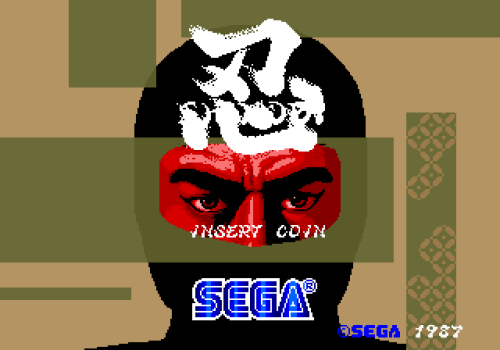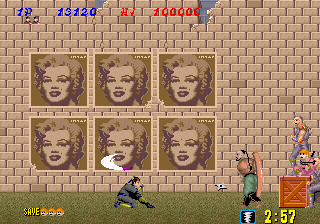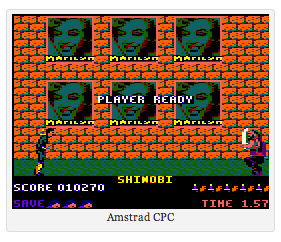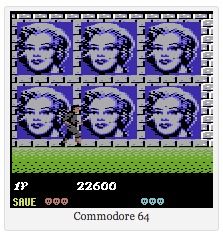
One of my favourite arcade games is Sega’s 1987 ninja hack-em-up Shinobi. You are Joe Musashi, a modern day ninja who runs a school…of ninja. One day, you find your students kidnapped by terrorists – a terrifying act indeed. Really, whoever kidnapped students from a ninja school must be extremely hardcore, but that thought doesn’t occur to you as you hit the streets to find your pupils armed only with your wits, your hands, your feet, uh, your throwing stars and your sword. Think it’s gonna be easy? Think again. The controls are tight, the music is fantastic, and the atmosphere is unparalleled.

Shinobi, arcade version.
One of the first encounters I had with this simple-in-concept-yet-amazing-in-execution game was years ago at a friend’s house. It was a far cry from the dingy arcades that had given birth to the game – a carefully housekept early 90s lounge room. “Don’t put your drinks down without coasters,” his mother warned as we excitedly ran from the kitchen to the lounge room with our cordial. He’d said he had something to show me, and since those ominous words are a lot more innocent when you’re a kid, I was excited.
In those days and in the income bracket my friends and I found ourselves born into, it was rare to have more than one TV in the house. Sometimes, if you were lucky, there’d be an ‘outside TV’; an older model often sporting wood paneling, a multitude of dials, and UHF. Laugh now, but those dials were integral to building upper arm strength. These TVs were invariably found in ‘games rooms’, ‘dens’, or any other secondary lounging space. Occupying the family TV for the frivolity of video games was seen as a major suburban faux pas, and would usually result in a clip ’round the ears or a slap if requests to do so weren’t submitted through the proper channels.
The greatest fear of the TV overlords seemed to be that “you’ll break the TV with that nonsense”, an observation painfully lacking in insight. Being able to play video games, especially on ‘the good TV’, was a powerful incentive for kids to learn the ins and outs of any model of television. Break it, parents? Why would we do that? Then we wouldn’t be able to play the games! The same logic applies to VHS players, but that’s another story.
My friend had turned 6 not so long before, and either from his parents following his strict instructions or from a hipper uncle or aunt, he’d received Shinobi for his Sega Master System.
Shinobi had been released for the system in 1988, and its violent blend of gritty street politics and daring rescue was more than enough to extinguish any desire for the day-glo bowl-cutted world of Alex Kidd (video games were supposed to be an escape from reality. Although that said, Sega soon produced Alex Kidd in Shinobi World, a game that appears to have reached into the future, read this criticism of Alex Kidd and then gone back to address those concerns). After a game had been on the shelf for two years, it was likely to be discounted, which is more than likely the reason my friend had received Shinobi for his birthday instead of a more recent release.

One look at the box was enough to know this game meant business. His eyes bore into you. They don’t implore to you save the kids, as do Michael Jackson’s on the cover of Moonwalker – they expect you’ve already saved them, and should only dare to meet his eyes if you’ve done so. If not, those shuriken just might be for you. The box provides you with everything you need. He’s Shinobi. You are Shinobi. GO NINJA GO!

Shinobi, Sega Master System version
Once the Sega had been powered up and Shinobi was dominating our senses, the lounge room – with its Nick Scali leather lounges, myriad coasters for sloppily poured drinks, tacky Copperart flourishes and smelling strongly of Glen 20 – brutally made way for the gloomy, crate-filled back alleys and sinister docks which provided the backdrop for the action. Super Mario Bros. had nothing on this. It felt real, like I could have left the house that moment and headed for the nearest harbour and uncovered a secret ninja base, and if the game hadn’t been so compelling, I might have.

Sega Master System
At the start of the second act of Stage 1, the game threw a curveball at us. “Who’s that?” I asked my shuriken-throwing friend, who had been selfless and kind enough to “show” me the game without me having to play it. “I dunno, maybe it’s his wife,” he said distractedly, as if answering the simple, even rhetorical question could result in his in-game death.
But who was that? Why would the game, which in the first level had been completely bereft of any kind of posters, suddenly get all arty? Who was the woman they’d chosen to feature so prominently? There was no way you could miss her, even though she didn’t add anything to the gameplay itself. My friend died so many times on that stage she became burned into our retinas. By the end of the afternoon we’d taken to calling her Madonna, as that seemed to fit the bill. Later, as my mother drove me home and away from any method of playing Shinobi, I had a sneaking suspicion we were wrong.
The use of Marilyn Monroe’s iconic image in Shinobi is a curious, but unforgettable choice. Perhaps they were seeking to tie the game into reality, or perhaps they just admired her visage. It certainly lends the game’s atmosphere a more realistic feel, and there’s something unsettling about the clash of 50s-60s iconography and 80s aesthetic it causes. Perhaps the Japanese developers saw Monroe as the epitome of American glamour, and the juxtaposition of that against the burned-out action scenes that provide Shinobi‘s backdrops was an artistic statement that proved irresistible. Maybe there’s a definitive explanation out there, but knowing that would take some of the magic out of it, don’t you think?
Shinobi was released on many platforms. According to Wikipedia, no less than 10 ports of the original arcade game have been released since November, 1987. All of these have featured the Marilyn stage, and all of them have interpreted the original in different ways. Let’s take a look.

Arcade
The original, and perhaps the most understated. The arcade game’s first level features posters (albeit of ninjas), making Marilyn less surprising when she turns up. But still, why? Eagle eyed readers might notice that her beauty spot has shifted to the middle of her forehead in the bottom right picture.

Sega Master System
My first exposure to this phenomenon, the Sega Master System jacks up the bright colours but remains a relatively faithful version of the original. Her beauty spot stays still this time, so it’s got that going for it.

Nintendo Entertainment System
Despite being a Sega game, an unlicensed version of Shinobi found its way to the competition. Accordingly, they’ve changed the source picture of Marilyn, making her look more like the Mulligrubs host than ever before. Those eyes…they’re just demonic.

PC Engine
Electronics giant NEC had a go at the whole video games thing in the late 80s-early 90s, and Shinobi was there. Marilyn doesn’t seem to approve, as her smile has vanished. Her face looks as if she had previously been smiling at someone who’d then started making lewd gestures, or perhaps she’s reacting to the imminent crotch damage that bloke in front of the crate’s about to take. Closest to the arcade, though.

Atari ST
Atari’s heyday was far behind it by the late 80s, when Shinobi appeared on its home computer, the ST. Immediately you’ll notice it’s a different picture – Marilyn is now winking at the player…or perhaps the programmer. A lot of lonely nights spent staring at a screen would go into ports like these, and a winking Marilyn Monroe isn’t the worst thing you could spend that time looking at. Bafflingly, the programmers didn’t seem to have much faith in the recognisability of Monroe’s likeness (and in the case of my friend and I, they were right), so they’ve helpfully added a little caption filling us in. All in all they put more effort into her picture than they did into that bad guy’s face. Some like it hot, indeed.

This looks horrendous. The Amstrad CPC should have been able to do a bit better than this, which has again used another picture of Marilyn. They’ve respected her pop-culture icon status a bit more than Atari, as her first name is all that’s necessary as a caption. Then again, the entire game features that Shinobi caption in the bottom centre, and I don’t think he’s quite reached the same legendary status as MM.

I’m sorry for trashing the Amstrad version, I really am. The designers here have chosen to accentuate Marilyn beyond even the player sprite, which blends into the background just like the villains. So despite not being able to see your guy and play the game properly, you can still get a fix of Marilyn’s smiling face, which is different yet again. She looks a bit like she’s laughing at the player’s poor performance, which her inclusion is causing. Fair shake, Marilyn.

Here they appear to have harkened back to the arcade original, despite the resolution being much worse. They’ve even gone so far as to replicate her beauty spot moving to her forehead in the last picture; nice attention to detail there.

Yikes. The IBM-PC version sees Faye Dunaway filling in for Marilyn. I don’t blame her for looking away either, I don’t think I could look at that action for very long.

Wii/XBLA
Sadly, licensing issues have led to Marilyn’s removal for the Wii and Xbox Live Arcade versions of the game. Couldn’t they have worked this out? How was it okay for the vintage versions of the game? Does this ruin the atmosphere? Ordinarily I’d say no, but they were too lazy to replace her with even the existing in-game ‘NINJA!’ posters you find most other places in the game. C’mon guys, I’ve paid my points. Transport me.
Monroe’s appearance in Shinobi has even inspired a complete exhibition by artist Ashley Anderson, who believes the initial instance was a tribute to Andy Warhol. Anderson has used a variety of the different Marilyns found above to create a series of modern works. A 60s icon’s insertion into an 80s arcade game corresponds to the theory that there’s a 20 year gap for mass nostalgia, which is why in the 90s we saw a lot of 70s stuff, and why we’ve only recently pulled ourselves out of that horrible 80s revival. Perhaps a game came out in the last few years with a Shinobi poster up on one of its walls? Sadly we’re a lot more litigious than back then, so I doubt it. Whatever the reason for or meaning of her inclusion, it can’t be argued that Marilyn Monroe’s Shinobi cameo isn’t visually arresting or strikingly original. After all, you don’t see James Dean in Sonic the Hedgehog.
A big thanks to Hardcore Gaming 101 for the pics of the various Marilyns.














